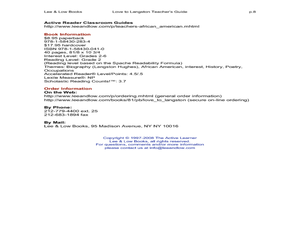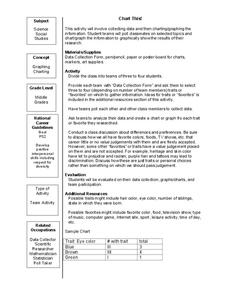Curated OER
A Mixed Bag of Apples
Middle schoolers recognize that individuals and groups have both common and different attributes and that each individual may be a member of many different groups. They recognize, appreciate and value individual differences and...
Curated OER
Fair Dinkum!
Students define fairenss, justice and equity as they are known to them. In groups, they role-play varoius scenerios and discuss their reactions to it. As a class, they share experiences in which they were treated unfairly and what could...
Curated OER
I am, you are, we are...
Students recognize that individual and groups have both common and different attributes and that each individual may be a member of many different groups. They choose a potato to paint a picture showing the character of their "friend"....
Curated OER
"It's Okay to be Different"
Students discuss the concepts of same and different and then listen to a read aloud of "It's Okay to be Different," by Todd Parr. They compare the outside of brown and white eggs and then the insides. They discuss how this applies to peo
Curated OER
Sadako and the Thousand Paper Cranes
Third graders explore their culture in comparison to Japanese culture by reading the book, Sadako and the Thousand Paper Cranes. They identify islands of Japan, create a Venn diagram comparing Japanese culture to American culture, and...
Curated OER
Korean TIP
Students discover different cultures and to compare and contrast those cultures to their own. They celebrate differences in culture as well as to better explore the dynamics of the similarities that make us one people. Students discuss...
Curated OER
Human Rights And Refugees: The Right To Asylum
Students read the Universal Declaration of Human Rights, define asylum and identify when people have the right to asylum. They examine specific cases of asylum in recent times and consider some of the difficulties refugees face.
Curated OER
Kill the Indian, Save the Man!
Students investigate primary sources from Carlisle Indian School including letters and photographs. In this investigative lesson students answer questions about their research.
Curated OER
One Survivor Remembers: Anti-Semitism
Students analyze and discuss how propaganda influenced anti-Semitism and it's role in World War II. In this propaganda lesson plan, students define the terms involved in this assignment. Then they will discuss their reactions to a film...
Curated OER
Smithsonian Asian Pacific American Lesson: Immigration
Many of your class members will have heard of Executive Order 9066 and the Japanese internment camps of World War II. Some may even recognize the terms “Issei” and “Nisei,” but few will have heard of Enemy Alien Hearing Boards, of the...
Curated OER
Black Actors in American Cinema
Young scholars examine the contributions of a few African American actors. After watching different films, they work together to recreate the film and the struggles faced by the actors. In groups, they compare and contrast the acting...
Curated OER
An Analysis of Jim Crow Laws and their Effects on Race Relations
First graders analyze the role of the Jim Crow laws on race relations. As a class, they are segregated based on the color shirt they have or some other simple criteria and wear either a square or circle sticker representing the majority...
Curated OER
Love To Langston
Students complete pre reading, writing, during reading, and interdisciplinary activities for the book Love To Langston. In this reading lesson plan, students complete journal entries, go over vocabulary, answer short answer questions,...
Curated OER
Court Documents Related to
Young scholars use the National Archives to researcj cout coduments related to Martin Luther King, Jr.
Curated OER
Chinese Immigration 1860s-1880s
Eighth graders consider the plight of Chinese immigrants to America. For this immigration lesson, 8th graders analyze political cartoons from the late 1800's that exemplify American public opinion regarding Chinese immigrants. The...
Curated OER
Lincoln, the Great Emancipator?
Students examine the motivating factors that prompted Lincoln to draft the Emancipation Proclamation in 1863. They examine Lincoln's social and political beliefs, particularly as they pertained to slavery and race in the United States.
Curated OER
African Americans in World War I - Lesson Two
Learners explore the decision to allow African Americans enlist in the military. In teams of three to four, students debate allowing Muslim Americans to enlist in the war. Learners not participating in the debate serve as legislatures....
Curated OER
The Power of Words: Social Justice Words
Young scholars role-play the position of a presidential candidate. They create their platform to include social justice programs and present it to the class. They answer questions to end the lesson.
Curated OER
Women's Achievements
Third graders read the passage in their textbook about Mary McLeod Bethune and discuss why education was important to her, and why she beleived that education allowed African American children to reach their potential. They then discuss...
Curated OER
More Simulations: Decisions, Decisions! and Flat Stanley
Students investigate the concepts related to instructing students using Flat Stanley in the Social Studies classroom. They examine the different instructional materials and are shown how to present the material to class. The focus is...
Curated OER
Chapter 10: Racial and Ethnic Relations
In this racial and ethnic relations in America worksheet, learners answer 15 matching questions and respond to 7 short answer questions regarding various racial and ethnic groups terms and issues in U.S. society.
Curated OER
Peace Partners
Students research the similarities of historically conflicting cultures and write a peace agreement for them. In this behavioral studies lesson, students discuss some world conflicts and forms they take. Students work in pairs and to...
Curated OER
Chart This!
Learners collect and analyze data. In this middle school mathematics lesson, students collect data on three to four traits or favorites. Learners analyze their data and create a chart of graph for each trait or favorite they researched.
Curated OER
Chart This!
Students collect data and graph or chart the information. In this data organization lesson, students poll their classmates about certain topics and chart or graph the information to show the results of their research.
Other popular searches
- Prejudice and Racism
- Pshe Racism and Prejudice
- She Racism and Prejudice
- Prejudice Racism and Bigotry

























